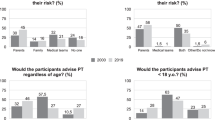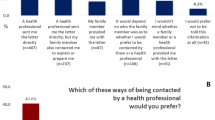Abstract
The uptake of predictive testing for Huntington disease informs our understanding of decision making by those at risk and assists with planning for service provision. Uptake figures have been reported from several centers based on the total number of people who have undertaken predictive testing as a percentage of those estimated to be at 50% risk in the region. This method produced a figure of 35% from our own service, much higher than observation of the local pedigrees indicated, and higher than other published reports. We have identified some errors in the commonly used formula. The major errors are the use of the cumulative total of those who have had testing with a static denominator of those at 50% risk, and the failure to exclude from the at-risk group those who are too young and therefore ineligible to test.
We report data from the Huntington Disease Register of Victoria and estimate the prevalence to be 8 per 100 000 in 1999. Additional data on individuals at risk were collated. We found that for every diagnosed person there were 4.2 individuals at 50% risk, a lower ratio than one to five hypothesized in the literature. We examined these ratios in the context of uptake.Significantly, we provide a solution to the calculation of uptake with a formula that factors in a dynamic denominator and corrects for the number of years testing has been offered. Using this formula, we calculated an uptake of 13.0–15.4% for the state of Victoria, Australia. This formula can be used to compare uptake across different centers.
Similar content being viewed by others
Log in or create a free account to read this content
Gain free access to this article, as well as selected content from this journal and more on nature.com
or
References
Taylor SD : Demand for predictive genetic testing for Huntington's disease in Australia, 1987 to 1993. Med J Aust 1994; 161: 351, 354–355.
Conneally PM : Huntington disease: genetics and epidemiology. Am J Hum Genet 1984; 36: 506–526.
Laccone F, Engel U, Holinski-Feder E et al: DNA analysis of Huntington's disease: five years of experience in Germany, Austria, and Switzerland. Neurology 1999; 53: 801–806.
Maat-Kievit A, Vegter-van der Vlis M, Zoeteweij M, Losekoot M, van Haeringen A, Roos R : Paradox of a better test for Huntington's disease. J Neurol Neurosurg Psychiatry 2000; 69: 579–583.
Harper PS, Lim C, Craufurd D : Ten years of presymptomatic testing for Huntington's disease: the experience of the UK Huntington's Disease Prediction Consortium. J Med Genet 2000; 37: 567–571.
Goizet C, Lesca G, Durr A : Presymptomatic testing in Huntington's disease and autosomal dominant cerebellar ataxias. Neurology 2002; 59: 1330–1336.
Creighton S, Almqvist EW, MacGregor D et al: Predictive, pre-natal and diagnostic genetic testing for Huntington's disease: the experience in Canada from 1987 to 2000. Clin Genet 2003; 63: 462–475.
Tibben A, Frets PG, van de Kamp JJ et al: Presymptomatic DNA-testing for Huntington disease: pretest attitudes and expectations of applicants and their partners in the Dutch program. Am J Med Genet 1993; 48: 10–16.
Bloch M, Fahy M, Fox S, Hayden MR : Predictive testing for Huntington disease: II. Demographic characteristics, life-style patterns, attitudes, and psychosocial assessments of the first fifty-one test candidates. Am J Med Genet 1989; 32: 217–224.
Trembath MK, Tassicker RJ, Collins VR, Mansie S, Sheffield LJ, Delatycki MB : Fifteen years of experience in predictive testing for Huntington disease at a single testing center in Victoria, Australia. Genet Med 2006; 8: 673–680.
Craufurd D, Dodge A, Kerzin-Storrar L, Harris R : Uptake of presymptomatic predictive testing for Huntington's disease. Lancet 1989; 2: 603–605.
International Huntington Association and the World Federation of Neurology Research Group on Huntington's Chorea: Guidelines for the molecular genetics predictive test in Huntington's disease. J Med Genet 1994; 31: 555–559.
Australian Bureau of Statistics. Demography Victoria: 3311.2, 2000. http://www.ausstats.abs.gov.au/Ausstats/subscriber.nsf/0/4F87599421188193CA256B250081F093/$File/33112_2000.pdf.
Roos RA, Hermans J, Vegter-van der Vlis M et al: Duration of illness in Huntington's disease is not related to age at onset. J Neurol Neurosurg Psychiatry 1993; 56: 98–100.
Foroud T, Gray J, Ivashina J et al: Differences in duration of Huntington's disease based on age at onset. J Neurol Neurosurg Psychiatry 1999; 66: 52–56.
Hayden M : Predictive testing for Huntington's disease: a universal model? Lancet Neurology 2003; 2: 141–142.
Acknowledgements
We thank Pamela Marshall, Social Worker in Predictive Testing, Huntington Disease Service, Launceston General Hospital, whose astute clinical observations and concern about uptake calculations also prompted this paper; and for comment on the text. We also thank Mavis Tassicker for comment on statistical concepts. MB Delatycki is a National Health and Medical Research Council Practitioner Fellow.
Author information
Authors and Affiliations
Corresponding author
Rights and permissions
About this article
Cite this article
Tassicker, R., Teltscher, B., Trembath, M. et al. Problems assessing uptake of Huntington disease predictive testing and a proposed solution. Eur J Hum Genet 17, 66–70 (2009). https://doi.org/10.1038/ejhg.2008.142
Received:
Revised:
Accepted:
Published:
Issue date:
DOI: https://doi.org/10.1038/ejhg.2008.142
Keywords
This article is cited by
-
Presymptomatic testing of those at 25% risk of autosomal dominant neurodegenerative disease- testing team beware
European Journal of Human Genetics (2019)
-
Ethics in genetic counselling
Journal of Community Genetics (2019)
-
Incidental findings of uncertain significance: To know or not to know - that is not the question
BMC Medical Ethics (2016)
-
CAG repeat size in Huntingtin alleles is associated with cancer prognosis
European Journal of Human Genetics (2016)
-
22 Years of predictive testing for Huntington’s disease: the experience of the UK Huntington’s Prediction Consortium
European Journal of Human Genetics (2016)



